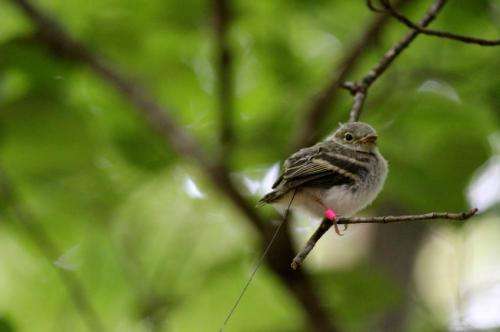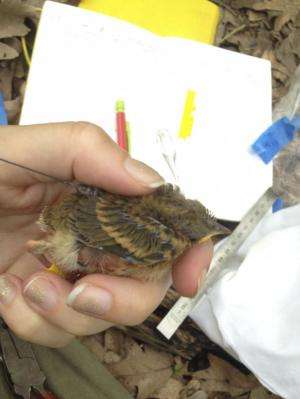'Teenage' songbirds experience high mortality due to many causes, study finds

Nearly one-third of songbird species across North America are experiencing long-term declines. Scientists have spent years researching potential causes for these population declines, focusing on the birds when they have just hatched as well as when they are adults. Now, researchers from the University of Missouri and the U.S. Department of Agriculture have found that songbirds are vulnerable to environmental dangers particularly when they are juveniles, shortly after they have left their parents' nests. Frank Thompson, a scientist with the USDA Forest Service and an associate cooperative professor in the MU College of Agriculture, Food and Natural Resources (CAFNR), worked with several colleagues to find that the majority of juvenile bird deaths occur in the first three weeks after they leave the nest.
"Just like teenagers leaving home to live on their own for the first time, these juvenile birds are inexperienced and vulnerable to the outside world," said Thompson. "It is important for these young birds to find acceptable habitats and shelter for them to survive on their own. Therefore, it is important for conservationists to find ways to provide the right habitats for these birds to survive during what is an important, yet vulnerable, time in their development."
Thompson says juvenile birds often seek different types of habitats compared to their parents. He says that juvenile songbirds often prefer denser foliage such as shrub land and young forest, compared to more open, older forests where their parents may have nested.
"It is important for conservation groups and land managers to know exactly what types of habitats need to be provided in order to protect these birds," Thompson said. "Providing habitats needed by breeding adult birds won't make much of a difference if those birds don't survive long enough to reach adulthood because they don't have adequate shelter when they are young. This approach is part of a growing focus on full-cycle conservation for migrant song birds"

Thompson says many studies have looked into mortality rates for fully grown birds as well as chicks that have just hatched, but not enough work has been done on juvenile birds that have just left the nest and are becoming independent. He recommends further study on this important life stage for songbirds in order to better understand specific causes for high mortality rates.
The study was published in the Journal of Wildlife Management.
Journal information: Journal of Wildlife Management
Provided by University of Missouri-Columbia





















